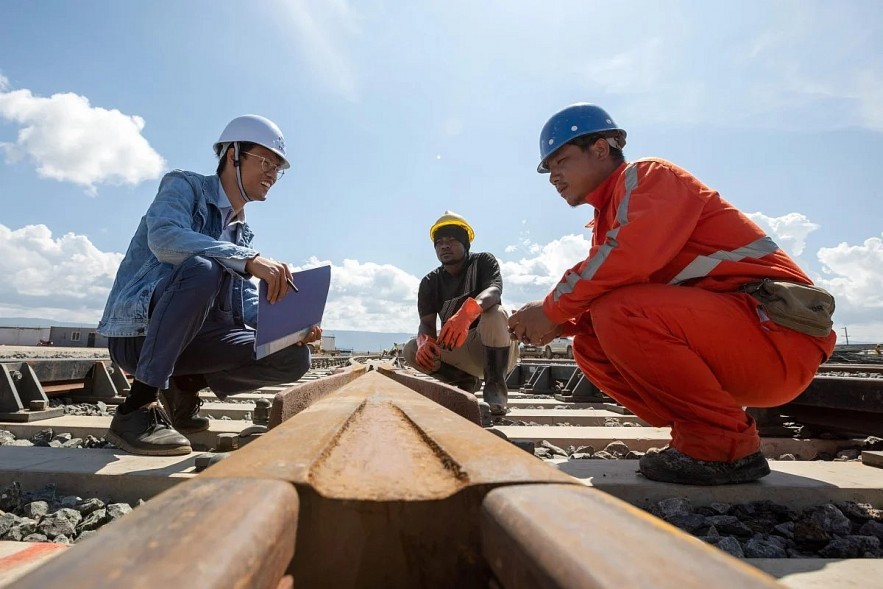 |
| The number of Chinese workers in Africa has drastically decreased since its peak in 2015 due to the pandemic and the decline in funding for projects. Photo: Xinhua |
Accompanying these workers were thousands of Chinese migrants, reaching a peak of around 263,000 in Africa in 2015.
However, since then, the number of Chinese workers in Africa has plummeted as funding for infrastructure projects has dried up, exacerbated by the impact of the coronavirus pandemic.
According to a working paper published in February by the International Monetary Fund (IMF) on China’s economic engagements in Africa, the official number of Chinese workers in Africa by the end of 2021 was approximately 93,000, marking a 64% decrease from 2015.
In Algeria and Angola, nearly 90% of registered Chinese workers left. The paper also noted that the actual total might be slightly higher as it did not include informal migrants such as private traders, investors, and shopkeepers.
The decline in workers can be directly linked to the gross annual revenues of Chinese companies’ construction projects in Africa.
“There is a positive correlation between the number of Chinese workers and the gross revenues of Chinese companies in Africa, especially before the pandemic,” stated the IMF paper.
The revenue generated by Chinese companies involved in engineering and construction projects in Africa peaked in 2015 and has been gradually declining. In 2021, the revenue figure reached US$37 billion, a 3% drop from the previous year.
According to data compiled by the China Africa Research Initiative (CARI) at Johns Hopkins University’s School of Advanced International Studies (SAIS), the number of Chinese workers in Africa further decreased to a record low of 88,371 in 2022.
The decline can be primarily attributed to the impact of the pandemic. In 2020 alone, the number of workers halved due to travel challenges caused by Covid-19.
“Construction activities were still affected in 2022 due to Covid-19. China did not open its borders until January 2023,” explained Deborah Brautigam, director of CARI.
According to CARI data, out of the 93,526 Chinese workers in Africa in 2021, 72,526 were involved in project contracting, while 21,000 were in various services such as manufacturing labor, hotel work, and cooking. In 2022, the numbers were 62,686 and 25,685, respectively.
The top five countries with the highest number of Chinese workers in Africa in 2022 were the Democratic Republic of the Congo, Algeria, Egypt, Nigeria, and Angola, which accounted for 42% of the total Chinese workers in Africa.
CARI data also revealed that the number of Chinese workers declined significantly in Angola, from 50,526 in 2013 to 6,784 in 2022. Similarly, Algeria experienced a drop from 91,596 Chinese workers in 2015 to 7,462 in 2022.
Dominik Kopinski, an associate professor at the University of Wroclaw’s Institute of Economics and senior adviser at the Polish Economic Institute, attributed the decline in Angola to two factors: the economic crisis following the post-2014 oil price drop and the reduction of Chinese loans.
This resulted in the departure of most Chinese state-owned enterprises (SOEs) and their workers, as well as many Chinese businesses catering to Chinese migrants, such as restaurants.
Kopinski highlighted that after the civil war ended in Angola in 2002, the government relied heavily on Chinese firms for national reconstruction, leading to a significant influx of Chinese SOEs, subcontractors, and approximately 300,000 migrants.
“Today, estimates vary, but based on our interviews conducted in 2022, there are around 20,000 Chinese migrants living in Angola,” he stated.
Kopinski expected the figure to increase gradually, with small family businesses, traders, and farmers venturing into less urban areas where others are hesitant to go, similar to Portuguese migration after 1910.
However, Egypt has shown a different trend, as the number of Chinese workers has increased in recent years, albeit in small increments. Significant projects undertaken by Chinese companies at the Suez Canal and the new administrative capital in Cairo led to a rise in the number of Chinese workers from just over 2,000 in 2015 to 7,358 in 2022.
A similar situation can be observed in the Democratic Republic of the Congo, where Chinese investors and workers have continued to be involved in the country’s mining industry, which supplies a majority of China’s cobalt. The number of Chinese workers in the DRC increased from 5,155 in 2014 to 8,705 in 2021. These figures do not include many undocumented Chinese migrants running small businesses, including artisanal mining.
Brautigam emphasized that the presence of Chinese workers is closely tied to project finance availability, such as bank lending in Angola and the Republic of Congo or commodity export revenues in Algeria.
She pointed out that Chinese project lending plateaued and then declined after reaching its peak in 2013 due to the increased perceived risks associated with falling commodity prices, including oil.
“As a result, fewer new projects were initiated and fewer workers were sent,” Brautigam concluded.
She also noted that part of the decline is due to Chinese companies increasingly hiring local workers as they establish a longer presence in a country.
“Furthermore, the sharp drop in numbers seen in 2020 and 2021 reflects the impact of the pandemic,” she added.
Brautigam predicted that while there will be some recovery in the future, the numbers are unlikely to reach the levels seen in the past decade.
“We are unlikely to see a return to the high numbers of the past decade,” she concluded.



